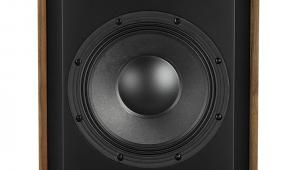Bowers & Wilkins Cm9 (£1760)
I admit to double-checking the price of the CM9 because it appears to offer such a lot of hardware for the money. As well as being one of the largest speakers here, it has four drivers including B&W’s highly regarded FST midrange unit whose woven Kevlar cone, rather than having a conventional roll surround, is swaged at the edge and rests on a ring of foamed plastic which operates in compression. This novel arrangement improves the dissipation of cone vibrations but limits the available cone excursion, making the FST unit unsuitable for reproducing bass frequencies.
So here the CM9 hands over to twin 165mm bass drivers (effective diameter about 132mm) which are reflex loaded via B&W’s familiar dimpled Flowport. This exits on the rear panel and forms part of the moulding that carries the two pairs of input terminals, the lower of which connects via the crossover to the bass drivers, the upper pair feeding the midrange section and B&W’s familiar 25mm aluminium dome tweeter.
A sight for sore eyes, the CM9 is surely the handsomest speaker here, particularly in the black lacquer finish of the review pair. Little design felicities like the brushed aluminium driver surrounds, the bite taken out of the tweeter faceplate by the FST driver and flush driver fasteners add up to a meticulously conceived and thoroughly modern piece of technological art.
NOT ONLY A LOOKER
And those classy looks do not deceive: the CM9 delivers an equally opulent sound. One of the first adjectives I wrote in my listening notes was ‘creamy’ and that stands as a good one-word summary of the CM9’s sonic character. Its pegged-back presence band adds tonal warmth and recesses the stereo image somewhat, but the overall result is far from dull.
On the Linn Records’ clarinet recording it projected a large, spacious, airy image but still conveyed the soaring dynamics and delineated the piano accompaniment. Bass output was a tad too heavy on the Davenport track – something which will certainly be room dependent – but the soundstage was large and the dynamics and rhythm were well portrayed, albeit softened.
RICH PICKINGS
Bass output was again a little heavy with the Alison Krauss number but you could hear the true quality of her voice despite the processing in the recording. Within the context of the CM9’s slightly reined-back delivery the dynamic was well controlled and musical strands were beautifully expressed.
Listening to the CM9 after the Spendor and Dynaudio in this group, ‘Double Trouble’ was the best yet – a little thickened in the bass but big sounding in every respect and with an authentic rough edge to Clapton’s vocal.
Originally published in the August 2009 issue























































